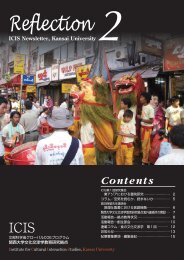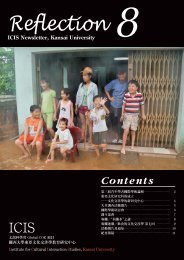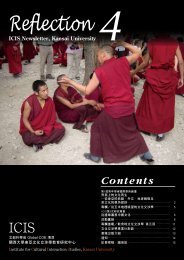English
English
English
You also want an ePaper? Increase the reach of your titles
YUMPU automatically turns print PDFs into web optimized ePapers that Google loves.
Cultural Reproduction on its Interface<br />
―From the Perspectives of Text, Diplomacy, Image of Others,<br />
and Tea Culture in East Asia<br />
ICIS the First International Academic Forum for the Next Generation<br />
On the 13th and 14th of December 2008, the First International Academic Forum for the Next Generation was held at<br />
Kansai University. This forum provided opportunities for presenting and discussing in multiple specialties on the theme<br />
of contributing to the research of cultural interaction studies. This is a program where young scholars of the next<br />
generation will be the front-runners and carry out on their own study plan. This forum had set four themes: diplomacy;<br />
image of others; text; and tea culture in order to discuss cultural conflicts, reproduction, and transformation of culture in<br />
areas of cultural contact and the boundaries of East Asia.<br />
< Session 1 ><br />
Diplomacy as Cultural Interaction<br />
in Early-modern East Asia<br />
Structural Transformation of Ryukyu Kingdom in the<br />
17th to Early 18th Centuries: As the Intersection of<br />
Cultural Interaction<br />
OKAMOTO Hiromichi(COE-PD, ICIS, Kansai University)<br />
The Ryukyu Kingdom, which had<br />
maintained a tribute-investiture relationship<br />
with the Ming and Qing dynasties of China<br />
while remaining under the control of the<br />
Satsuma clan and the Tokugawa shogunate<br />
after 1609, had established diplomatic and<br />
cultural strategies by the beginning of the<br />
18th century. The kingdom’s diplomatic and cultural strategies<br />
covered the various levels of cultural interactions by the Ryukyu<br />
Kingdom, including dispatch of missions to Edo and reception of<br />
investiture missionaries. This is the origin of the “uniqueness of<br />
Ryukyu” that is still seen in today’s Okinawan society.<br />
Vietnamese-Japanese Diplomatic and Commercial<br />
Relations in the 17th Century<br />
HOANG Anh Tuan(Department of History, College of Social Sciences<br />
and Humanities, Vietnam National University, Hanoi)<br />
The position of Vietnam in Asian trading<br />
system from the early to the mid-17th<br />
century is described on the basis of<br />
relations with Japan. The “Quảng Nam<br />
Nguyễn” lords used the trade relationship<br />
with Japan to contend with the Trịnh loads.<br />
On the other hand, Vereenigde Oostindische<br />
Compagnie VOC (Dutch East India Company)launched into the<br />
silk trade between Tonkin and Japan in 1637 and achieved a certain<br />
level of success. Japan had great influence on Vietnam, though<br />
Chinese people had played a role of agency in it.<br />
Dutch Political Attitudes in Asia : Diplomacy in the 18th<br />
Century Ceylon as Example<br />
Alicia SCHRIKKER (Research Institute of History, Faculty of<br />
Humanities, Leiden University)<br />
In the mid-17th century, VOC had<br />
advanced to the island of Ceylon and<br />
established economic concessions while<br />
accepting traditional formalities with the<br />
Kingdom of Kandy and behaving obediently.<br />
Upon the reversal of the situation due to the<br />
war after 1740, VOC switched to diplomacy<br />
without formalities, which drove the Kingdom of Kandy closer to<br />
England and other countries, so VOC was forced to resume diplomatic<br />
formalities. This is a typical example where the practice of traditional<br />
formalities in Asia locally was affected by the power relationships<br />
between both parties in local contexts.<br />
Comments<br />
HAMASHITA Takeshi(Faculty of Intercultural Communication,<br />
Ryukoku University)<br />
The three speakers reported the<br />
multilayered nature of cultural spaces in<br />
early-modern Asia. It is important to explore<br />
diplomacy and cultural interaction based not<br />
only on the central, but also on the peripheral<br />
and regional contexts and the trade structures<br />
within Asia. Also, VOC’s information<br />
management and Ryukyu’s cultural strategy highlight the importance<br />
of studying cultural interaction through information.<br />
2












